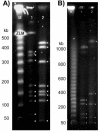Identification of Campylobacter jejuni ATCC 43431-specific genes by whole microbial genome comparisons
- PMID: 15231810
- PMCID: PMC438563
- DOI: 10.1128/JB.186.14.4781-4795.2004
Identification of Campylobacter jejuni ATCC 43431-specific genes by whole microbial genome comparisons
Abstract
This study describes a novel approach to identify unique genomic DNA sequences from the unsequenced strain C. jejuni ATCC 43431 by comparison with the sequenced strain C. jejuni NCTC 11168. A shotgun DNA microarray was constructed by arraying 9,600 individual DNA fragments from a C. jejuni ATCC 43431 genomic library onto a glass slide. DNA fragments unique to C. jejuni ATCC 43431 were identified by competitive hybridization to the array with genomic DNA of C. jejuni NCTC 11168. The plasmids containing unique DNA fragments were sequenced, allowing the identification of up to 130 complete and incomplete genes. Potential biological roles were assigned to 66% of the unique open reading frames. The mean G+C content of these unique genes (26%) differs significantly from the G+C content of the entire C. jejuni genome (30.6%). This suggests that they may have been acquired through horizontal gene transfer from an organism with a G+C content lower than that of C. jejuni. Because the two C. jejuni strains differ by Penner serotype, a large proportion of the unique ATCC 43431 genes encode proteins involved in lipooligosaccharide and capsular biosynthesis, as expected. Several unique open reading frames encode enzymes which may contribute to genetic variability, i.e., restriction-modification systems and integrases. Interestingly, many of the unique C. jejuni ATCC 43431 genes show identity with a possible pathogenicity island from Helicobacter hepaticus and components of a potential type IV secretion system. In conclusion, this study provides a valuable resource to further investigate Campylobacter diversity and pathogenesis.
Copyright 2004 American Society for Microbiology
Figures




Similar articles
-
Genomic diversity in Campylobacter jejuni: identification of C. jejuni 81-176-specific genes.J Clin Microbiol. 2005 May;43(5):2330-8. doi: 10.1128/JCM.43.5.2330-2338.2005. J Clin Microbiol. 2005. PMID: 15872262 Free PMC article.
-
Genomic evidence for interspecies acquisition of chromosomal DNA from Campylobacter jejuni by Campylobacter coli strains of a turkey-associated clonal group (cluster II).Foodborne Pathog Dis. 2008 Aug;5(4):387-98. doi: 10.1089/fpd.2008.0113. Foodborne Pathog Dis. 2008. PMID: 18673073
-
Whole genome comparison of Campylobacter jejuni human isolates using a low-cost microarray reveals extensive genetic diversity.Genome Res. 2001 Oct;11(10):1706-15. doi: 10.1101/gr.185801. Genome Res. 2001. PMID: 11591647 Free PMC article.
-
The Campylobacter jejuni glycome.FEMS Microbiol Rev. 2005 Apr;29(2):377-90. doi: 10.1016/j.femsre.2005.01.003. FEMS Microbiol Rev. 2005. PMID: 15808749 Review.
-
Post genome analysis of Campylobacter jejuni.Symp Ser Soc Appl Microbiol. 2001;(30):36S-44S. doi: 10.1046/j.1365-2672.2001.01352.x. Symp Ser Soc Appl Microbiol. 2001. PMID: 11422559 Review. No abstract available.
Cited by
-
Campylobacter jejuni type VI secretion system: roles in adaptation to deoxycholic acid, host cell adherence, invasion, and in vivo colonization.PLoS One. 2012;7(8):e42842. doi: 10.1371/journal.pone.0042842. Epub 2012 Aug 27. PLoS One. 2012. PMID: 22952616 Free PMC article.
-
Pan-Genome Analysis of Campylobacter: Insights on the Genomic Diversity and Virulence Profile.Microbiol Spectr. 2022 Oct 26;10(5):e0102922. doi: 10.1128/spectrum.01029-22. Epub 2022 Sep 7. Microbiol Spectr. 2022. PMID: 36069574 Free PMC article.
-
Natural transformation of Campylobacter jejuni occurs beyond limits of growth.PLoS One. 2012;7(9):e45467. doi: 10.1371/journal.pone.0045467. Epub 2012 Sep 26. PLoS One. 2012. PMID: 23049803 Free PMC article.
-
Exploring Lactobacillus plantarum genome diversity by using microarrays.J Bacteriol. 2005 Sep;187(17):6119-27. doi: 10.1128/JB.187.17.6119-6127.2005. J Bacteriol. 2005. PMID: 16109953 Free PMC article.
-
Genome sequence of a clinical isolate of Campylobacter jejuni from Thailand.Infect Immun. 2007 Jul;75(7):3425-33. doi: 10.1128/IAI.00050-07. Epub 2007 Apr 16. Infect Immun. 2007. PMID: 17438034 Free PMC article.
References
-
- Ahmed, I. H., G. Manning, T. M. Wassenaar, S. Cawthraw, and D. G. Newell. 2002. Identification of genetic differences between two Campylobacter jejuni strains with different colonization potentials. Microbiology 148:1203-1212. - PubMed
-
- Aspinall, G. O., C. M. Lynch, H. Pang, R. T. Shaver, and A. P. Moran. 1995. Chemical structures of the core region of Campylobacter jejuni O:3 lipopolysaccharide and an associated polysaccharide. Eur. J. Biochem. 231:570-578. - PubMed
-
- Bjorkholm, B. M., J. L. Guruge, J. D. Oh, A. J. Syder, N. Salama, K. Guillemin, S. Falkow, C. Nilsson, P. G. Falk, L. Engstrand, and J. I. Gordon. 2002. Colonization of germ-free transgenic mice with genotyped Helicobacter pylori strains from a case-control study of gastric cancer reveals a correlation between host responses and HsdS components of type I restriction-modification systems. J. Biol. Chem. 277:34191-34197. - PubMed
Publication types
MeSH terms
Substances
Associated data
- Actions
- Actions
Grants and funding
LinkOut - more resources
Full Text Sources
Other Literature Sources
Molecular Biology Databases

